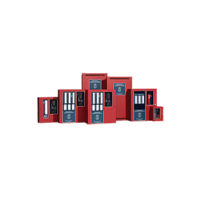When Independent School District (ISD) 196, located just outside Minneapolis, Minn., needed to replace its aging, problematic fire alarm systems across the 110-square-mile district, it had two main criteria to help keep its 28,000 students as safe as possible: a non-proprietary system capable of being installed, tested and maintained by any certified installer, and the ability to pinpoint the location of alarms to speed the response of first responders.
Like in many communities across the country, the ISD 196 school facilities (18 elementary schools, six middle schools and four high schools) are aging, along with their fire alarm systems, installed more than 20 years ago. The older systems were proprietary and used parts that are now obsolete. In addition to maintenance issues, the systems were in danger of not complying with the state’s stringent fire protection codes for schools.
The district added sprinkler systems to the schools several years ago, rendering some of the previously-installed equipment unnecessary. Yet, the older parts remained in place, making testing more complicated, time-consuming and costly than it needed to be. With no replacement parts to fix or update the antiquated systems, ISD 196 was left with no choice but to completely rip-and-replace the fire alarm systems, wiring and all. The district started the process in 2009 with the schools that were most in need as dictated by the fire marshal.
“Our first mandate when we went out to bid is that the system not be proprietary,” said Michael Schwanke, facilities manager for ISD 196. “We wanted the ability to call our local distributor and installer, and get a replacement part if something failed. We did not want to have to go through the process of replacing everything again or rerunning wire because parts couldn’t be found to fix the issue.”
The older systems were hardwired, high-voltage systems with 110-volt smoke detectors, and the district wanted to move to a simpler, processor-based system that was easy for the schools’ facilities managers to operate. In addition, the previous systems were older non-addressable, poorly-zoned systems — meaning if an alarm was triggered, the fire department would need to go in search of the problem from area to area.
“When we started to have problems more and more frequently, such as failed horns and strobes, we involved the fire marshal and were able to get approval to have some of the systems replaced,” Schwanke said.
An RFP process led ISD 196 to AFC Technologies, a local Minnesota low-voltage electrical contractor, offering a non-proprietary, commercial fire alarm solution from Silent Knight.
“Some of the systems were so old that trying to retrofit them didn’t make sense,” said Bill Karels, owner of AFC Technologies, which bid on the ISD 196 projects using the Silent Knight system. “Throughout the district, they had problems with control panels, deficiencies in strobes and decibel levels, and so on. They needed a simple, state-of-the-art system where they could easily find and install replacement parts if needed.”
AFC Technologies has replaced systems in eight of the ISD 196 schools, standardizing with the IntelliKnight 5820XL addressable fire alarm control panel, Silent Knight’s largest control panel, designed to cover the largest facilities, while offering capacity to handle future additions.
The schools’ new systems comprise basic “horns and strobes” for notification, but the Silent Knight system’s flexibility allows the district to easily add advanced features such as voice evacuation, mass notification and carbon monoxide detection, if required in the future, according to Silent Knight.
The Deep Freeze Test
Since installation of the Silent Knight system, the district has had fast fire detection that has been trouble-free. Given the system’s flexibility, the district was able to tie in a relay switch that allows each school to go into lockdown mode in an emergency. With the touch of a button, administrators can automatically close and lock all fire doors within a school, providing containment if an issue should occur.
The new systems have not yet been exposed to a real-life fire emergency, but they did jump into action when consecutive days of subzero temperatures in Minnesota froze sprinkler heads at one of the schools, setting off the sprinkler system.
“The alarm was activated and because of the addressable system, the fire department was able to quickly respond and disable the sprinklers, saving thousands of dollars in damage,” Schwanke said. “If the fire department wasn’t alerted and didn’t know exactly where to go when they got there, the building would have been flooded. That was a huge benefit of having the new system in place.”
The school district is continually reviewing the status of the fire alarm systems within its remaining schools and will potentially be replacing those systems as warranted.
“With a fire protection system, you really want it to last the life of the building,” said Karels of AFC Technologies. “You might need to upgrade the software or replace a device, but you want to position yourself so that you are not forced to start over. With the Silent Knight system, ISD 196 is positioned to avoid that from happening, and has the ability to add in more advanced features down the line if its requirements change.”
PROJECTS in the News
HID Global announced that its networked access controllers and readers were selected by the National University of Singapore Suzhou Research Institute (NUSRI) in China to enhance campus security and facility management. The solution leverages the university’s existing TCP/IP network investment to deliver a Web-based access control system. With dozens of geographically dispersed buildings that house expensive equipment, NUSRI’s new access control solution includes HID Global’s VertX® V1000 network controllers, VertX® V100 door/reader interfaces, and smart card readers to monitor access to different buildings and enable advance reservations functionality to access key campus facilities such as laboratories, hazardous materials storage rooms and machine rooms.
“The open architecture IP-based access control solution supports the system already deployed in the field to save cost,” said Mr. Xu, project manager of integrators of NUSRI. “Additionally, the system is scalable to enable future expansion, which addresses the growing demands of our campus and subsidiaries, while also providing better cost control.”
? ? ?
Brivo Systems LLC announced that Kimray Inc., a provider of petroleum industry control equipment located in Oklahoma City, Okla., standardized on the Brivo OnAirSM cloud-based access control solution for two of its current facilities, with plans to expand to a wide range of facilities and locations. Dowley Security Systems is the Brivo dealer and integrator for this ongoing project.
Like many enterprises, prior to upgrading to Brivo, Kimray relied on lock and key for their security. “A few years ago, our facilities director started looking into other options,” recalled Jeremy Biggs, Kimray’s loss prevention manager. “We wanted more control over our facilities.”
Kimray selected Brivo OnAir and it has been rolling out expanded access management control over the last year and a half. Thus far, Brivo manages eight exterior and 16 interior doors. In addition to covering all external door access, the Brivo system is installed to manage access to the several internal areas, such as storage and offices.
Brivo OnAir is integrated with the company’s duress system, so that when an employee triggers one of the panic buttons, their location is pinpointed and a record is maintained of such incidents. According to Biggs, “We’re able to react before we’ve even received a phone call. We’ve got a panic button in the Wellness Center, which is open 24/7. Security staff can’t be in the gym all day, so the button gives us an extra measure of security.” Eventually, Biggs plans to expand the duress stations to machining and other work areas.
With Brivo, Kimray manages approximately 941 users including employees, spouses and vendors. These users are divided into 108 groups, all with specific day, time, and location access privileges.
? ? ?
In the wake of devastating national flooding in the United Kingdom (UK), security systems are being deployed in a bid to minimize future damage and provide an early-warning system to residents. Lighting specialists Raytec, Mobotix and Farson Digital Watercams have teamed up to provide a system designed to monitor river conditions in the UK.
Designed by Farson Digital Watercams, the nationwide HD camera network using Mobotix cameras provides real-time video feeds of multiple river sites 24/7. The Raytec Infra-Red LED lighting allows the system to operate 24/7; even during hours of complete darkness, Raytec stated in a press release.
With VARIO holographic lens technology providing even light distribution, the IR lighting allows the camera system to provide images of the scene at night, with zero light pollution.
The network camera system allows interested parties to view live footage of the rivers at any time, day or night. This is especially crucial for monitoring locations that are isolated or difficult to access.
? ? ?
March Networks announced that American wine and spirits superstore Total Wine & More standardized on its retail video surveillance solution. The privately-owned chain is using the March Networks offering to maintain its security and loss prevention efforts across 100 outlets located in 15 states and to capture video evidence to assist with liability protection as it grows its e-commerce business.
Total Wine, which is adding 12-15 new stores annually, transitioned to the March Networks 8000 Series Hybrid NVRs and Visual Intelligence software when it began opening Internet fulfilment centers in its stores. The 25,000-square-foot retail outlets hold nearly 14,000 types of wines, beers and spirits and feature walk-in cigar humidors and keg rooms, wine tasting areas and classrooms. While existing analog cameras are in place to monitor the stores’ public areas, Total Wine needed high-definition (HD) IP cameras to capture data when packaging bottles that could retail for up to $2,000. The 8000 Series recorders can support a mix of analog and IP cameras or as many as 32 IP cameras, giving Total Wine the freedom to transition to HD video as its business requirements evolve.
“We didn’t want to abandon our analog cameras, and the March Networks solution allowed us to add more IP cameras to our build-out where and when we needed them,” said Total Wine Senior Project Manager Mark Ganter. “We’re very happy with the solution and the support we have received. We have such vast coverage that we can see almost every part of a store, and we now use the video surveillance system if we need to investigate a problem or inspect an area in any of our stores.”











